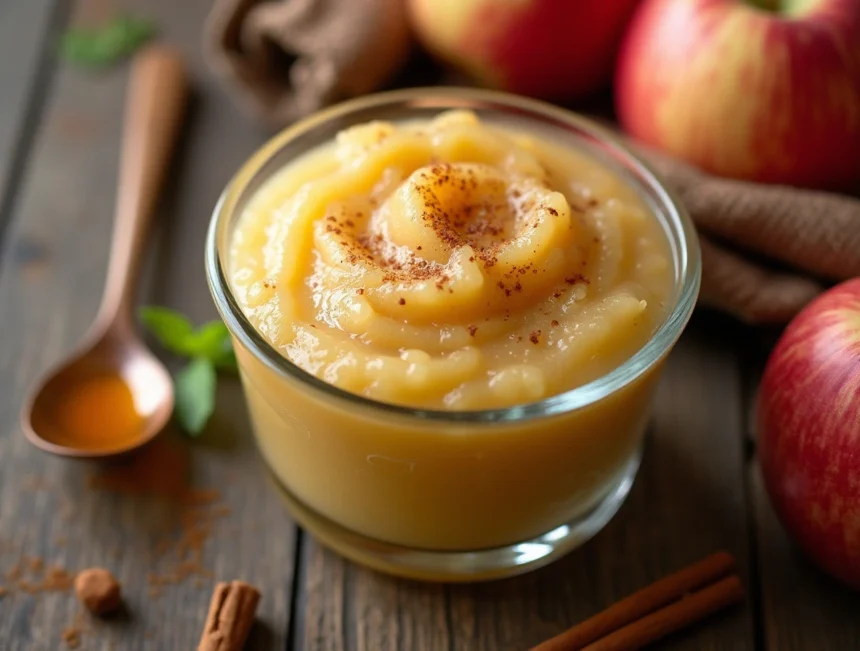When autumn arrives with its crisp air and colorful foliage, there’s nothing quite like the comforting aroma of homemade applesauce simmering on the stove. This versatile, wholesome treat brings back childhood memories while offering a healthier alternative to commercially produced versions. With just a handful of ingredients and minimal effort, you can create a batch of applesauce that’s perfectly tailored to your taste preferences – whether you prefer it chunky or smooth, sweetened or naturally tart.
The beauty of making applesauce at home lies in its simplicity and adaptability. It’s the perfect way to use those slightly bruised apples sitting in your fruit bowl or to preserve a bounty from apple picking. You’ll be amazed at how much more vibrant and flavorful homemade applesauce tastes compared to store-bought versions. Plus, you control exactly what goes into it – no preservatives, artificial flavors, or excessive sugars – just pure, natural goodness that celebrates the essence of fresh apples.
So grab your apples and let’s transform them into a delicious homemade applesauce that will have everyone asking for seconds!
What Is Homemade Applesauce?
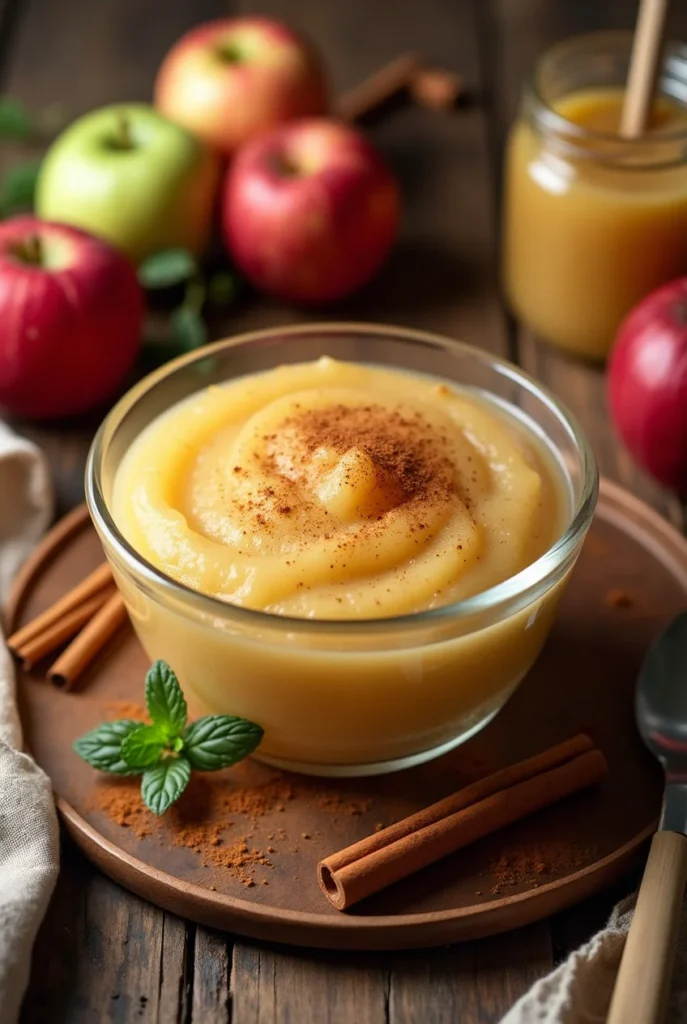
Have you ever wondered why something so simple as cooked, mashed apples has remained a beloved staple across generations? Homemade applesauce is exactly what it sounds like – apples that have been softened through cooking and then pureed to your desired consistency. But it’s so much more than just that! It’s the canvas for your creativity, the perfect way to preserve autumn’s bounty, and as my grandmother used to say, “the quickest path to making the house smell like heaven.” Whether you’re spreading it on toast, serving it alongside pork chops, or enjoying it as a wholesome snack, homemade applesauce brings a touch of nostalgia to any meal. Ready to give it a try? I promise you’ll never go back to store-bought!
Why You’ll Love This Homemade Applesauce
Nature’s Perfection, Enhanced
There’s something magical about transforming fresh apples into a silky, aromatic sauce. This recipe allows the natural flavors of the apples to shine while giving you complete control over the texture. Want it chunky? No problem. Prefer it velvety smooth? You’ve got it. The natural sweetness of carefully selected apples means you might not even need to add sugar, making this a truly wholesome treat that celebrates the fruit’s inherent goodness.
Budget-Friendly Brilliance
Making applesauce at home is incredibly economical, especially during apple season when prices drop and varieties abound. Even better, this recipe is perfect for rescuing “imperfect” apples – those with bruises or slight blemishes that might otherwise go to waste. One batch using 5 pounds of apples yields approximately 4 cups of applesauce, which costs significantly less than premium store-bought varieties and tastes infinitely better.
Versatile Flavor Canvas
The beauty of homemade applesauce lies in its adaptability. The base recipe is delicious on its own, but you can easily customize it with warm spices like cinnamon, nutmeg, or cloves. For a more indulgent version, a touch of brown sugar and butter transforms it into a dessert-worthy treat. One of the best things about this recipe is how quickly it comes together – in less than an hour, you’ll have a delicious, aromatic sauce that delivers wonderful apple flavor with minimal effort. The quick cooking time preserves the brightness of the fruit while still developing that perfect comfort-food consistency. Ready to start creating your signature version?
How to Make Homemade Applesauce
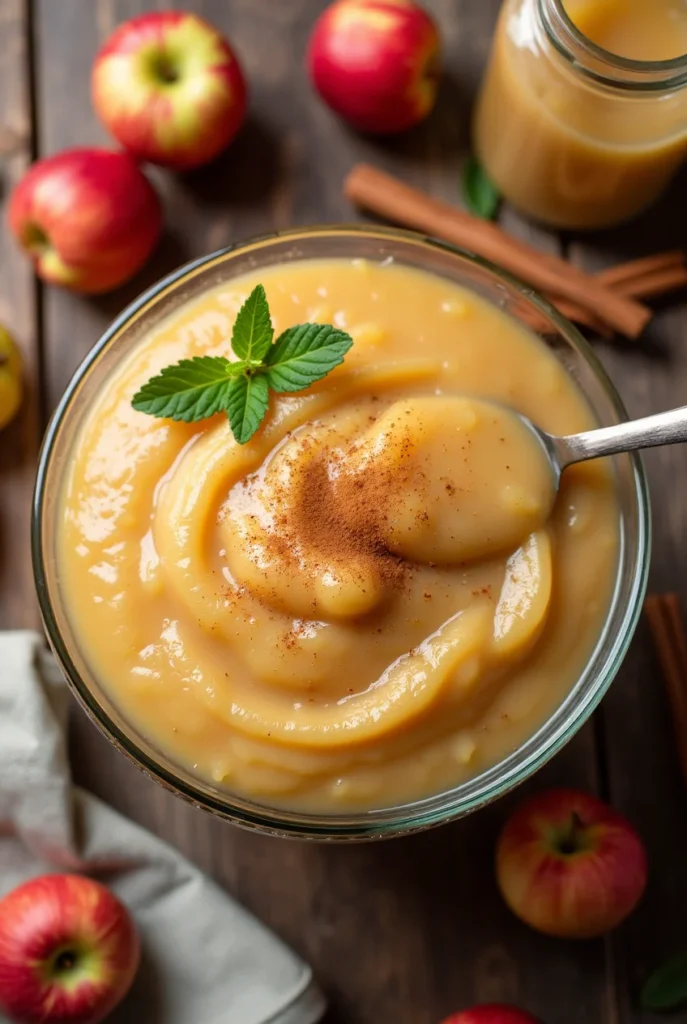
Quick Overview
This homemade applesauce recipe strikes the perfect balance between simplicity and flavor. With just 10 minutes of prep time and about 40 minutes of cooking, you’ll have a delicious, versatile applesauce that’s miles better than anything from the store. The secret lies in using a variety of apples for complex flavor and the addition of a cinnamon stick that infuses the sauce without overwhelming it. Best of all, this recipe is forgiving and adaptable – perfect for both cooking novices and seasoned chefs.
Key Ingredients for Homemade Applesauce
- 5 pounds mixed apples (such as McIntosh, Golden Delicious, Granny Smith, Fuji, Gala, Honeycrisp, or Jonathan): Using a variety creates a more complex, balanced flavor. Choose sweeter apples like Fuji or Honeycrisp if you plan to minimize added sugar.
- 1 cup water: Just enough liquid to create steam and help the apples break down without making them soggy.
- 2 tablespoons lemon juice: Adds brightness and helps balance the sweetness while preventing browning.
- 1 whole cinnamon stick: Infuses a subtle warmth without overwhelming the apple flavor.
Optional additions:
- 1/2 cup brown sugar: For those who prefer a sweeter applesauce or are using particularly tart apples.
- 2 tablespoons butter: Creates a richer, more decadent applesauce.
- 1/2 teaspoon ground cinnamon: For additional warmth if you remove the cinnamon stick.
- 1/2 teaspoon vanilla extract: Adds depth and complements the apple flavor beautifully.
Detailed Step-by-Step Instructions
- Prepare the apples: Wash, peel, and core all 5 pounds of apples. Cut them into small, uniform chunks (about 1-inch pieces) to ensure even cooking. Don’t worry about bruised spots – they’ll cook down perfectly fine.
- Combine ingredients: Transfer the apple chunks to a large pot or Dutch oven. Add 1 cup of water, 2 tablespoons of lemon juice, and the cinnamon stick.
- Bring to a boil: Cover the pot and heat over medium-high heat until the mixture reaches a boil. The steam will help soften the apples quickly.
- Reduce and simmer: Once boiling, reduce the heat to low and maintain a gentle simmer. Keep the pot covered and cook for 20-30 minutes, stirring occasionally to prevent sticking. The apples are ready when they can be easily pierced with a fork.
- Remove cinnamon stick: Before pureeing, fish out the cinnamon stick and set it aside (or discard it).
- Puree to desired consistency: Use an immersion blender directly in the pot for the easiest method. Alternatively, carefully transfer batches to a blender or food processor. For chunkier applesauce, pulse briefly. For smoother sauce, blend longer.
- Taste and adjust: Sample your applesauce and decide if you’d like to add any optional ingredients. If using brown sugar, stir it in while the sauce is still warm so it dissolves completely.
- Optional finishing step: For a more dessert-like applesauce, return the pureed sauce to low heat and stir in brown sugar, butter, ground cinnamon, and/or vanilla extract. Cook uncovered for about 10 minutes, stirring occasionally, to thicken slightly.
- Cool and store: Allow the applesauce to cool before transferring to airtight containers. It will thicken slightly as it cools.
What to Serve Homemade Applesauce With
Homemade applesauce is incredibly versatile and pairs beautifully with numerous dishes:
For breakfast, try it dolloped on oatmeal or yogurt, spread on toast, or folded into pancake batter. It adds moisture and natural sweetness to your morning meal.
As a side dish, it’s a classic accompaniment to pork chops, roasted pork loin, or sausages. The subtle acidity cuts through the richness of the meat perfectly.
For dessert, warm it slightly and serve with a scoop of vanilla ice cream or use it as a topping for pound cake. You can even layer it in parfaits with granola and whipped cream.
For a unique pairing, try serving warm applesauce alongside savory latkes (potato pancakes) with a dollop of sour cream for a delightful contrast of flavors and textures.
5 Top Tips for Perfecting Homemade Applesauce
- Mix apple varieties for complex flavor: Combine sweet apples (like Fuji or Honeycrisp) with tart varieties (like Granny Smith) for balanced flavor. McIntosh and Golden Delicious break down easily and create a smooth texture.
- Save time with smart shortcuts: If peeling 5 pounds of apples seems daunting, try a mechanical apple peeler-corer-slicer tool, which can process an apple in seconds. Alternatively, for a rustic version with added nutrition, leave the peels on red apples (they’ll blend in) and simply remove the cores.
- Adjust texture without extra tools: No immersion blender? No problem! For a chunky, rustic applesauce, use a potato masher. For ultra-smooth results, press the cooked apples through a fine-mesh sieve or food mill.
- Create flavor variations: Experiment with different spices like star anise, cardamom, or nutmeg. For unique twists, try adding 1 teaspoon of grated ginger for a subtle zing or a splash of bourbon for an adult version.
- Prevent browning naturally: If you’re prepping apples ahead of time, place the cut pieces in a bowl of cold water with a splash of lemon juice to prevent browning until you’re ready to cook them.
Storing and Reheating Tips
Homemade applesauce stores beautifully, making it perfect for batch cooking:
Refrigeration: Transfer cooled applesauce to airtight containers and refrigerate for up to 2 weeks. The flavors often improve after a day as they meld together.
Freezing: For longer storage, freeze applesauce in freezer-safe containers or heavy-duty freezer bags for up to 6 months. Leave about 1/2 inch of headspace in containers as the sauce will expand when frozen. Thaw overnight in the refrigerator before using.
Canning: For shelf-stable applesauce, process it in sterilized jars using a water bath canning method. Properly canned applesauce will keep for up to 1 year in a cool, dark place.
Reheating: Applesauce can be enjoyed cold, at room temperature, or warm. To reheat, microwave small portions in 30-second intervals, stirring between each, or warm gently on the stovetop over low heat, adding a splash of water if needed to restore consistency.
3 Reasons to Make Applesauce at Home Instead of Buying It

- Superior flavor and freshness: Commercial applesauce often contains preservatives and can taste flat compared to the vibrant flavor of homemade.
- Control over ingredients: When you make applesauce at home, you decide exactly what goes in it – no high fructose corn syrup, artificial flavors, or unnecessary additives.
- Adaptable to dietary needs: Easily make sugar-free, low-sodium, or organic applesauce tailored to specific dietary requirements without paying premium prices for specialty versions.
Health Benefits of Apples in Homemade Applesauce
Apples aren’t just delicious; they’re packed with nutrition that carries over into your homemade applesauce:
The soluble fiber in apples, particularly pectin, supports digestive health and may help lower cholesterol levels. Even when cooked, apples retain much of their fiber content, making applesauce a gut-friendly food.
Apples contain a range of antioxidants, including quercetin, catechin, and chlorogenic acid, which help fight inflammation and oxidative stress in the body. These compounds remain present in cooked applesauce.
For those watching their sugar intake, homemade applesauce allows complete control over added sweeteners. The natural sugars in apples provide sweetness without the glycemic spike of refined sugars, especially when no additional sweeteners are added.
Frequently Asked Questions About Homemade Applesauce
How do I control the texture of my applesauce?
One of the greatest advantages of making applesauce at home is customizing the consistency exactly to your preference. For chunky applesauce with tender bits of fruit throughout, use a potato masher to break down the cooked apples while maintaining some texture. A hand mixer on low speed offers slightly more breakdown while still preserving some apple chunks. When smooth applesauce is your goal, an immersion blender works wonderfully directly in the cooking pot. Alternatively, transfer the cooked apples in batches to a traditional blender or food processor for the silkiest possible texture. Remember that applesauce thickens slightly as it cools, so it’s best to aim for a consistency just slightly thinner than your final goal.
Can I make applesauce in kitchen appliances besides a stovetop pot?
Absolutely! Your slow cooker and pressure cooker are excellent alternatives that require even less monitoring. For slow cooker applesauce, combine peeled, cored, and chopped apples with water, lemon juice, and your cinnamon stick, then cook on high for 3-4 hours until the apples completely soften. For Instant Pot enthusiasts, add the same ingredients to the pressure cooker insert, seal properly, and cook at high pressure for just 10 minutes followed by a natural pressure release. Both methods yield delicious results with minimal effort. Simply puree to your desired consistency after cooking using any of the methods mentioned above.
Is homemade applesauce suitable for canning?
Homemade applesauce is perfect for canning and preserving that fresh apple flavor year-round! Since apple varieties vary in natural acidity, proper food safety requires adding acid to ensure safe preservation. Add 1 tablespoon of bottled lemon juice (which has consistent acidity levels) or 1/2 teaspoon of citric acid per quart of applesauce before canning. Once your applesauce reaches the hot, ready-to-can stage, ladle it carefully into properly sterilized jars, maintaining 1/2 inch of headspace. After wiping the rims clean and securing the lids, process pint jars for 15 minutes or quart jars for 20 minutes in a boiling water bath canner. When properly processed and stored in a cool, dark environment, your homemade applesauce will maintain quality for up to one full year.
Which apple varieties make the best applesauce?
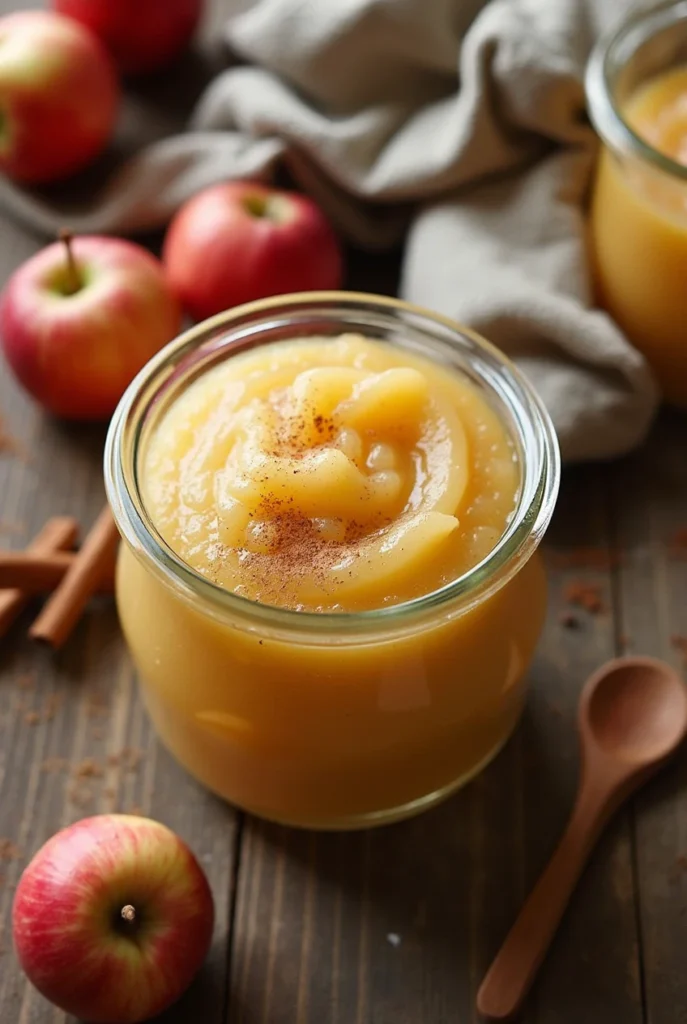
The secret to extraordinary applesauce lies in combining different apple varieties rather than relying on just one type. This creates complexity in both flavor and texture. Sweet varieties like Fuji, Golden Delicious, Gala, Honeycrisp, and McIntosh bring natural sweetness and break down easily during cooking. Tart varieties including Granny Smith, Braeburn, Jonathan, and Pink Lady contribute brightness and prevent the sauce from becoming too sweet. For balanced flavor, aim for approximately half sweet and half tart apples. McIntosh apples cook down exceptionally well, making them ideal for smoother applesauces, while firmer varieties like Honeycrisp maintain more structure if you prefer chunkier results. Using whatever apples you have on hand will still yield delicious results. This recipe is very forgiving!
How can I customize the flavor of my applesauce?
Homemade applesauce is essentially a canvas for creativity. While the basic recipe produces a naturally sweet, apple-forward flavor, numerous variations await:
Sweet Additions: Beyond brown sugar, try natural sweeteners like honey (for floral notes), pure maple syrup (for caramel undertones), or coconut sugar (for a hint of molasses flavor). Start with just 1-2 tablespoons per batch and adjust to taste.
Dessert-Style Applesauce: Transform your applesauce into a decadent treat by stirring in 2 tablespoons of butter, 1/2 cup brown sugar, 1/2 teaspoon of ground cinnamon, and 1/2 teaspoon of vanilla extract after cooking. This rich version makes an incredible topping for vanilla ice cream.
Fruit Blends: Create custom fruit sauces by substituting up to half the apples with ripe pears for a delicate apple-pear sauce. For berry variations, add 1 cup of fresh or frozen strawberries, blueberries, or raspberries during the final 10 minutes of cooking time. These additions introduce beautiful color and complementary flavors.
Spice Profiles: While cinnamon is traditional, consider these spice combinations:
- Warming Blend: 1/2 teaspoon cinnamon, 1/4 teaspoon nutmeg, and a pinch of ground cloves
- Autumn Harvest: 1 teaspoon pumpkin pie spice
- Subtle Sophistication: 1/4 teaspoon cardamom and a star anise pod (remove before pureeing)
- Spicy Kick: 1/4 teaspoon cinnamon and a pinch of ground ginger
Can I reduce sugar in homemade applesauce?
Absolutely! One of the greatest benefits of homemade applesauce is controlling the sugar content. For naturally sweet applesauce without added sweeteners, focus on using naturally sweet apple varieties like Fuji, Gala, and Golden Delicious as the majority of your apple mixture. Adding a cinnamon stick during cooking enhances perceived sweetness without any sugar. For those monitoring sugar intake, consider using monk fruit sweetener or stevia as zero-calorie alternatives to sugar. Start with very small amounts (equivalent to 1-2 tablespoons of sugar) and adjust to taste after cooking.
How long will homemade applesauce keep?
Properly stored homemade applesauce keeps remarkably well. In airtight containers in the refrigerator, expect 10-14 days of freshness. For longer storage, freezing is excellent. Applesauce maintains its quality in the freezer for up to 6 months in freezer-safe containers with 1/2 inch headspace for expansion. When ready to use, simply thaw overnight in the refrigerator. For true long-term preservation, properly canned applesauce remains shelf-stable for up to 12 months when stored in a cool, dark place. Always check for signs of spoilage before consuming, regardless of storage method.
Can I use applesauce as a substitute in baking?
Homemade applesauce works wonderfully as a healthier substitute in many baking recipes! Replace oil or butter with an equal amount of unsweetened applesauce to reduce fat while maintaining moisture in muffins, quick breads, and some cake recipes. For best results, substitute only half the called-for fat with applesauce to preserve some richness. Applesauce also makes an excellent egg replacement in vegan baking. Use 1/4 cup applesauce per egg in recipes where eggs primarily provide moisture rather than structure. As a bonus, applesauce adds subtle sweetness, allowing you to reduce added sugar by up to 25% in many recipes.
Is homemade applesauce nutritionally superior to store-bought?
Homemade applesauce typically offers better nutritional value than commercial versions. Without preservatives, artificial flavors, or high fructose corn syrup found in many store brands, homemade applesauce contains only natural ingredients. When made with the apple peels left on (and subsequently blended), homemade applesauce retains significantly more fiber and polyphenols, beneficial plant compounds with antioxidant properties. Additionally, controlling sugar content allows you to maximize the natural nutritional benefits of apples, including vitamin C, various B vitamins, and potassium, without drowning them in added sweeteners. The minimal processing and fresh preparation also help preserve heat-sensitive nutrients that might be diminished in commercially processed products.
Try These Delicious Recipes for More Healthy Ideas
If you enjoyed making your own applesauce, why not explore these other tasty and nutritious recipes? From refreshing salads to satisfying smoothies, there’s something for every occasion:
- Sweet Potato Mash – A creamy, comforting side dish that pairs perfectly with savory meals.
- Cucumber Salad – Light, refreshing, and the perfect side to balance out your meal.
- Caesar Salad Dressing – Make your own creamy dressing to top off any salad.
- Asparagus Quinoa Salad – A healthy, vibrant salad to complement your applesauce-inspired dishes.
- Apple Pie Smoothie Recipe – A smoothie that brings the warm flavors of apple pie to your glass.
- Peanut Butter Banana Smoothie – A delicious, protein-packed snack or breakfast option.
- Pina Colada Smoothie – A tropical treat that’s both sweet and healthy.
- Healthy Snacks – Discover a variety of snack ideas to fuel your day with wholesome goodness.
- Healthy Snacks for Work – Quick, easy, and nutritious snacks to keep you energized at work.
Explore these recipes to keep your meals fun, flavorful, and healthy! Try them today and enjoy a balanced lifestyle.
Print
Want to save this recipe?
Want to save this recipe? Enter your email below, and we'll send it straight to your inbox. Plus, receive new recipes every week!
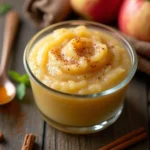
Homemade Applesauce
- Total Time: 50 minutes
Description
This homemade applesauce balances the natural sweetness of mixed apples with a hint of cinnamon and bright lemon notes. Infinitely adaptable and surprisingly simple, it’s the perfect way to capture autumn’s bounty in a versatile, wholesome treat that’s miles better than store-bought varieties.
Ingredients
- 5 pounds mixed apples (McIntosh, Golden Delicious, Granny Smith, Fuji, Honeycrisp, or Jonathan)
- 1 cup water
- 2 tablespoons lemon juice
- 1 whole cinnamon stick
Optional Additions:
- 1/2 cup brown sugar
- 2 tablespoons butter
- 1/2 teaspoon ground cinnamon
- 1/2 teaspoon vanilla extract
Instructions
- Peel and core the apples, then cut into small chunks about 1-inch in size.
- Transfer the apple chunks to a large pot and add water, lemon juice, and the cinnamon stick.
- Cover and bring to a boil over medium-high heat.
- Reduce heat to low, keeping the pot covered, and simmer for 20-30 minutes, stirring occasionally, until apples are fork-tender.
- Remove the cinnamon stick from the pot.
- Use an immersion blender, food processor, or standard blender to puree the apples to your preferred consistency – smooth or chunky.
- Taste the applesauce and incorporate any optional ingredients if desired.
- For a sweeter, dessert-style applesauce, return the puree to the pot after blending and stir in brown sugar, butter, ground cinnamon, and/or vanilla extract. Cook uncovered over low heat for about 10 minutes until slightly thickened.
- Allow to cool before transferring to storage containers.
Alternative Cooking Methods
- Instant Pot: Combine all ingredients in the pressure cooker. Seal and cook on high pressure for 10 minutes, then allow natural release.
- Slow Cooker: Add all ingredients and cook on high for 3-4 hours until apples are completely soft.
- Prep Time: 10 minutes
- Cook Time: 40 minutes
- Category: Side Dish
- Cuisine: American
Nutrition
- Serving Size: 1/2 cup
- Calories: 227 kcal
- Sugar: 43g
- Sodium: 31mg
- Fat: 3g
- Saturated Fat: 2g
- Unsaturated Fat: 1.3g
- Carbohydrates: 53g
- Fiber: 7g
- Protein: 1g
- Cholesterol: 8mg


